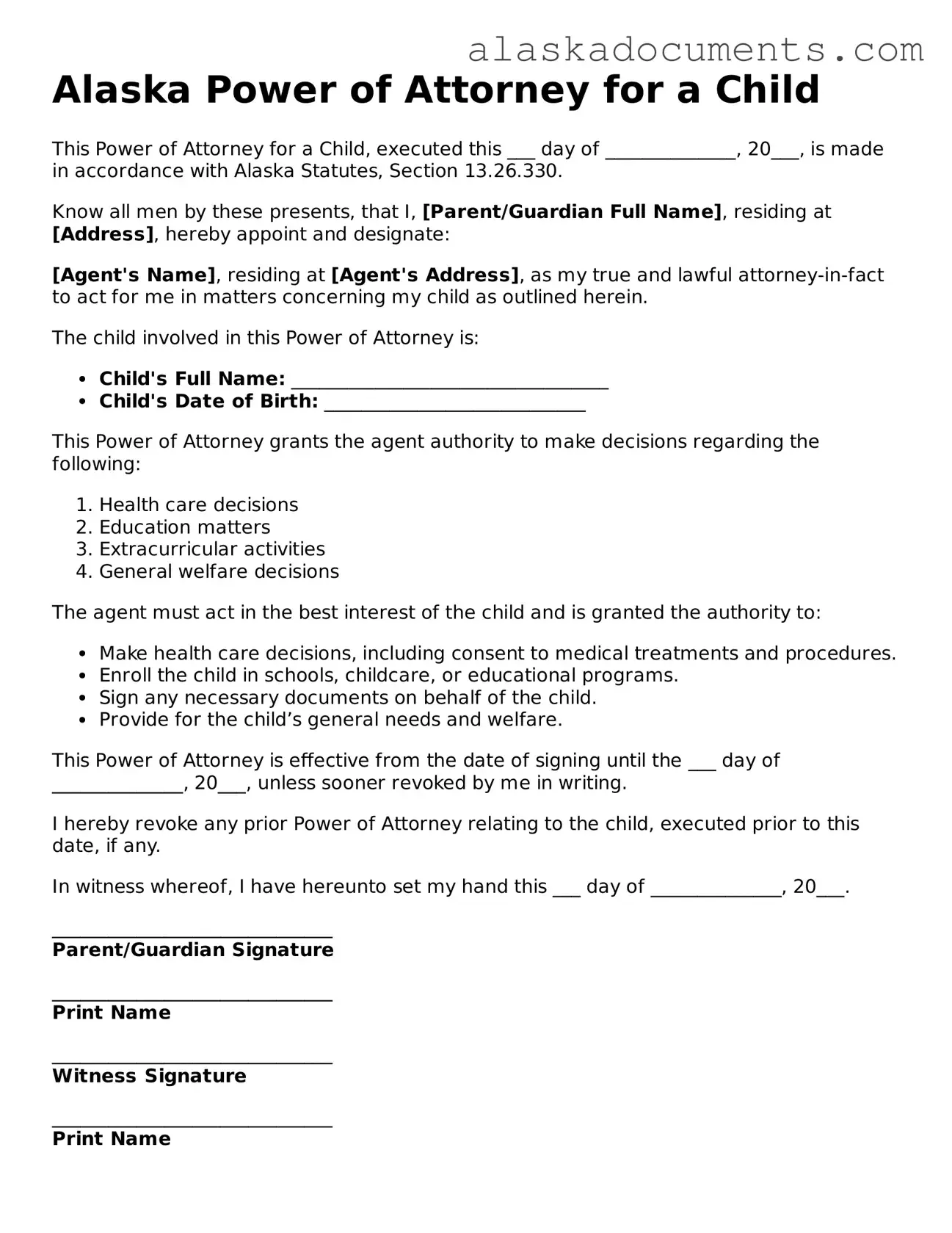The Alaska Power of Attorney for a Child form is similar to a General Power of Attorney. Both documents allow an individual to designate another person to make decisions on their behalf. In the case of a General Power of Attorney, this can cover a wide range of areas, including financial and legal matters. However, the Power of Attorney for a Child specifically focuses on the care and custody of a minor, providing authority to make decisions related to the child's well-being, education, and healthcare.
Another related document is the Medical Power of Attorney. This form grants someone the authority to make medical decisions for another person when they are unable to do so. While the Alaska Power of Attorney for a Child can include medical decisions, the Medical Power of Attorney is specifically tailored for healthcare-related matters. It ensures that a trusted individual can advocate for the child’s medical needs in critical situations.
The Temporary Guardianship Agreement also shares similarities with the Alaska Power of Attorney for a Child. This document allows a parent or legal guardian to appoint someone else to care for their child for a limited time. While both documents aim to provide care and protection for a child, a Temporary Guardianship Agreement is often used for shorter durations, such as during a parent's absence due to travel or illness.
A Child Custody Agreement is another relevant document. This legal arrangement outlines the rights and responsibilities of parents or guardians regarding the care of a child. While the Alaska Power of Attorney for a Child does not establish custody in the same way, it can provide temporary authority for decision-making, which may overlap with custody issues, especially in situations where parents are separated or divorced.
The Child Care Authorization form is similar in that it allows a parent to authorize another individual to care for their child. This document can be used for daycare or school purposes. Like the Power of Attorney for a Child, it focuses on the child's immediate care but does not grant the same level of decision-making authority regarding education or healthcare.
The Standby Guardian form is another document that parallels the Alaska Power of Attorney for a Child. This form allows a parent to designate a standby guardian who can assume care of the child in the event of an emergency or incapacity. While both documents address the care of a child, the Standby Guardian form is typically activated only under specific circumstances, whereas the Power of Attorney can be more broadly utilized for ongoing care.
The Consent to Travel form is also relevant. This document provides permission for a child to travel with someone other than their parents. While it does not grant decision-making authority, it complements the Alaska Power of Attorney for a Child by ensuring that the designated individual has the necessary consent for travel, which can be crucial for vacations or trips.
The Adoption Consent form is another similar document. This form is used when a biological parent agrees to the adoption of their child by another individual or couple. While the Alaska Power of Attorney for a Child does not terminate parental rights, both documents involve the transfer of certain responsibilities regarding a child's upbringing and care.
The Foster Care Agreement is also comparable. This document outlines the arrangement between a biological parent and a foster parent or agency. It establishes the terms under which a child will be cared for while away from their biological family. Like the Power of Attorney for a Child, it addresses the child's welfare but typically involves a more formal arrangement with social services.
Understanding the intricacies of child care documents can be complex, yet resources such as the TopTemplates.info provide valuable templates that simplify the process, ensuring that all necessary forms, including the Power of Attorney for a Child, are readily available for parents and guardians navigating these important decisions.
Lastly, the Child Support Agreement can be considered similar. While this document focuses on financial responsibilities for a child's upbringing, it often accompanies other arrangements, including custody and care decisions. The Alaska Power of Attorney for a Child can work alongside a Child Support Agreement to ensure that the child's needs are met holistically, covering both care and financial aspects.
